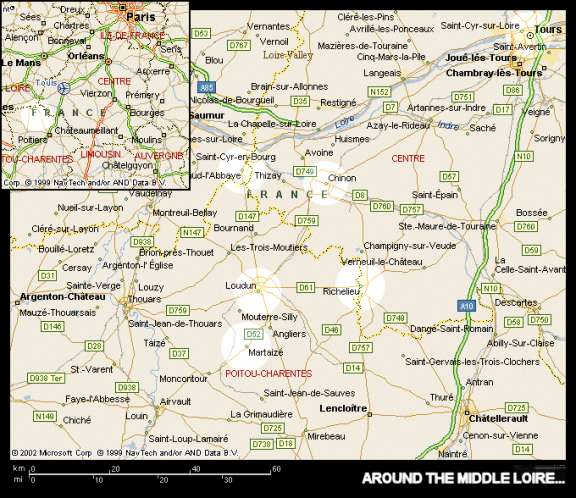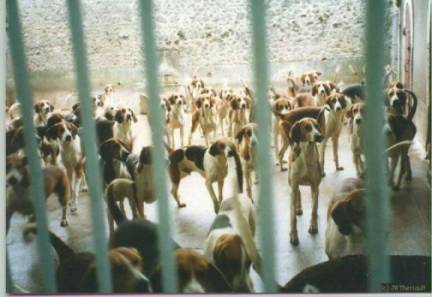| CHAMBORD,
the largest and most extravagant of the Loire chateaux... and architecturally
controversial. Commissioned by Francois I, the Sun King as his little "hunting
lodge". Designed by Italian Domenico de Cortona as Italian Renaissance
but built by French masons as French medieval architecture. |
 |
Rosemary and I had
spent the winter planning this 'Grande Tour de France' and finally, it
was April and we were off to Paris. Our itinerary was Avignon, La Rochelle,
Quimper, the Loire Valley and Paris. So on arriving in Paris, we headed
for the Gare de Lyons and took the 'Train de Grande Vitesse (TGV)' to Avignon
where we spent a week touring the Provençale countryside and...
we danced on the Pont d'Avignon!
Then, it was on to
the west coast to La Rochelle for a few days mainly to visit the port and
waterfront area. As we walked around the port area and looked at the same
towers and harbor that Jehan and Perrine saw when they came to Larochelle
to leave for the New World, I felt a special connection to my ancestral
grandfather and grandmother and their brave fellow pioneers.
Afterwards, we continued
northwest to the picturesque province of Brittany for a few days in the
Quimper area and then turned eastward to the magical middle Loire valley
with those spectacular chateau's and the Terriot ancestral homeland.
 |
CHENONCEAUX,
an exquisitely beautiful chateau on the Loire... it reflects the
River Cher which flows into the Loire at Tours. The chateau's most characteristic
feature, the set of arches spanning the River Cher was built by Diane de
Poitiers (mistress of King Henry II) after the chateau was begun in 1515.
Catherine de Medicis (wife of Henry II) completed the castle... after
she evicted Diane. |
What a historic site...
and such beauty! This is the place of origin of England's Plantagenet dynasty...
these grounds were the object of the Hundred Years' War. A war ended by
Saint Joan of Arc, a young maiden barely twenty years old. Two English
Kings: King Henry II and King Richard, the Lion Hearted are buried here
at the Abbey of Fontevraud just south of the Loire and a short drive from
Martaizé.
Not far from Fontevraud
to the east is Chinon and its castle on the Vienne River which dates to
the Roman times. Chinon is where Jeanne D'Arc paused to consult with her
King after her victory at Orleans. It is now the site of a very interesting
museum on Joan of Arc in the castle's Tour de L'Horloge. The castle at
Chinon unfortunately is mostly in ruins due largely to Cardinal Richelieu's
pillaging around 1630 to create his own 'chateau' in present-day Richelieu.
 |
TOUR THE MIDDLE
LOIRE:
Within 100km of Martaisé are the following points to visit: Aulnay
(probable home of Jehan Terriau's mother and father), La Chaussee (Maison
de l'Acadie), Frontevraud (Burial place in the Abbey of King Richard, the
Lion-Hearted and King Henry II), Richelieu (built by Cardinal Richelieu
in 1630), Chinon (castle-fort which houses the Tour de l'Horloge, St Joan
of Arc Museum), several castles including Chenonceaux, Chambord, and Cheverny
(working castle built in 1604; continues to be used by a descendant who
uses it as a hunting lodge... must see!), Les Eaux Melles in Roiffe (birthplace
of Izacc de Razilly who along with Charles de Menou d'Aulnay, led the first
group of 300 Frenchmen to La Heve, Acadia. |
 Traveling south towards
Poitiers from Fontevraud to the city of Loudun situated on a hill, there
are two very noticeable features in the skyline: one, a stone belfry and
the other, a square tower from the 11th century which set the
character of the town. Our Acadian ancestors, Jehan and Perrine Terriot
and their relatives and other ancestors came to the fairs and festivals
of this city from the other parts of the region. At that time, Loudun was
an important fortress whose gateway still exists today. Rich in history,
Loudun once knew the likes of important figures like Theophraste Renaudat,
the founder of the French press in 1632. When Isaac de Razilly and his
crew of 300 'select men' departed for Acadia, Renaudot reported this news
in his newspaper 'The Gazette'.
Traveling south towards
Poitiers from Fontevraud to the city of Loudun situated on a hill, there
are two very noticeable features in the skyline: one, a stone belfry and
the other, a square tower from the 11th century which set the
character of the town. Our Acadian ancestors, Jehan and Perrine Terriot
and their relatives and other ancestors came to the fairs and festivals
of this city from the other parts of the region. At that time, Loudun was
an important fortress whose gateway still exists today. Rich in history,
Loudun once knew the likes of important figures like Theophraste Renaudat,
the founder of the French press in 1632. When Isaac de Razilly and his
crew of 300 'select men' departed for Acadia, Renaudot reported this news
in his newspaper 'The Gazette'.
Continuing towards
Poitiers from Loudun, is the Seigneurie d'Aulnay which includes Martaizé.
Martaizé today, is a small farming village with a friendly Pastor
leading his Catholic parish. The village is mindful of its role in Acadian
history. It is a part of 'la ligne Acadienne'... a line which identifies
the area as the ancestral origins of Acadia.
There is a well-maintained
museum closeby in La Chaussee called 'La Maison de L'Acadie'. At the time
of our visit, the museum was under the care of Monsieur Gigon who took
time to give personal tours to any returning Acadians.
The displays are
informative and have been carefully prepared. As we walked around in La
Chaussee, I couldn't help but think about the departure of the first Acadians.
As written by G. Massignon and M. Caillebeau, a number of carts gathered
in front of the little church of La Chaussée loaded with the farmers,
their families and their few belongings. They awaited Monsieur Le Curé's
blessing and fond farewells from their friends. Vincent Landry, the Notaire,
was there amid the crowd. Then Martin Le Godelier, Lord of the village,
solemnly lead the expedition away as they slowly started their five-day
trip to La Rochelle and their eventual destination in the New World.
There are several
other sites in the area which are important to Acadian history. Isaac de
Razilly was born in the village of Roiffé8between
Fontevraud and Loudun. He led the first group of 300 Frenchmen to Acadia
in 1632 along with Charles de Menou Seigneur D'Aulnay. D'Aulnay knew alot
about farming and his mother owned the fiefdom which included La Chaussee,
Aulnay and Martaizé.
Terriot's still live
in Martaizé although the spelling convention in France for the name
seems to be either Terriot or Therriot. The flat farm lands which stretch
out around the village from horizon to horizon, are rich and well-manicured.
Change comes slowly in these small French villages. They are mindful of
their long history. So, I suspect that except for the obvious modern conveniences
and construction, this little village has not changed much since Jehan
and Perrine left here for La Rochelle and beyond.
We kept a journal
during our tour. So, click on the Terriot crest to check out our entries
for those 4-5 days that we spent in the Middle Loire area.
| THE HUNTING DOGS
OF CHEVERNY; Cheverny... a chateau built in the early
1600's. It continues today to be inhabited by the descendants of the original
owner but is also open to the public... so one might call this a 'working
chateau'? Compared to Chenonceaux, it is a relatively modest castle,
however it is a gem in many other respects: the grounds are superb... a
great spot to bring a picnic lunch, and the inside is loaded with history,
beautiful antiques and a very friendly staff. |
 |
|